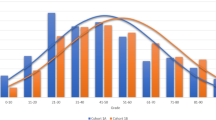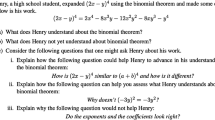Abstract
We report findings from a classroom experiment in which each of two sections of the same Calculus 1 course at a North American research-focused university were subject to an “intervention” week, each for a different topic, during which a less-experienced instructor encouraged a much higher level of student engagement, promoted active learning (answering “clicker” questions, small-group discussions, worksheets) during a significant portion of class time and built on assigned pre-class tasks. The lesson content and analysis of the assessments were informed by existing research on student learning of mathematics and student interviews, though the interventions and assessments were also intended to be compatible with typical course practices in an attempt to appeal to practitioners less familiar with the literature. Our study provides an example of active learning pedagogy (including materials and assessment used) for students at this level of mathematics in a classroom of over one hundred students, and we report improved student performance—on conceptual items in particular—with a switching replication in that each section outperformed the other on the topic for which it received the intervention.


Similar content being viewed by others
References
Adair, J. G., Sharpe, D., & Huynh, C.-L. (1989). Hawthorne control procedures in educational experiments: A reconsideration of their use and effectiveness. Review of Educational Research, 59(2), 215–228.
Ambrose, S. A., Bridges, M. W., DiPietro, M., Lovett, M. C., & Norman, M. K. (2010). How learning works: Seven research-based principles for smart teaching. San Francisco, CA: Jossey-Bass.
Andrews, T. M., Leonard, M. J., Colgrove, C. A., & Kalinowski, S. T. (2011). Active learning not associated with student learning in a random sample of college biology courses. CBE Life Sciences Education, 10(4), 394–405.
Asiala, M., Cottrill, J. F., Dubinsky, E., & Schwingendorf, K. E. (1997). The development of students’ graphical understanding of the derivative. The Journal of Mathematical Behavior, 16(4), 399–431.
Bransford, J. D., Brown, A. L., & Cocking, R. R. (Eds.) (2003). How People Learn: Brain, Mind, Experience, and School. Psychology (Expanded.). Washington D.C.: National Academy Press.
Bressoud, D. M., Carlson, M. P., Mesa, V., & Rasmussen, C. (2013). The calculus student: insights from the Mathematical Association of America national study. International Journal of Mathematical Education in Science and Technology, 44(5), 685–698.
Carlson, M., Jacobs, S., Coe, E., Larsen, S., & Hsu, E. (2002). Applying covariational reasoning while modeling dynamic events: A framework and a study. Journal for Research in Mathematics Education, 33(5), 352–378.
Crouch, C. H., & Mazur, E. (2001). Peer Instruction: Ten years of experience and results. American Journal of Physics, 69, 970.
Deslauriers, L., Schelew, E., & Wieman, C. (2011). Improved learning in a large-enrollment physics class. Science (New York, N.Y.), 332(6031), 862–864.
Dubinsky, E. D., & McDonald, M. A. (2002). APOS: A constructivist theory of learning in undergraduate mathematics education research. In D. Holton, M. Artigue, U. Kirchgräber, J. Hillel, M. Niss, & A. Schoenfeld (Eds.), The teaching and learning of mathematics at university level (pp. 275–282). The Netherlands: Springer.
Engelke, N. (2007). Students’ understanding of related rates problems in calculus. Arizona State University.
Epstein, J. (2013). The calculus concept inventory—measurement of the effect of teaching methodology in mathematics. Notices of the AMS, 60(8), 1018–1026.
Hake, R. R. (1998). Interactive-engagement versus traditional methods: A six-thousand-student survey of mechanics test data for introductory physics courses. American Journal of Physics, 66(1), 64–74.
Hora, M., & Ferrare, J. (2009). Structured observation protocol for instruction in Institutions of Higher Education (IHEs). WI: Madison.
Klymchuk, S., Zverkova, T., Gruenwald, N., & Sauerbier, G. (2010). University students’ difficulties in solving application problems in calculus: Student perspectives. Mathematics Education Research Journal, 22(2), 1033–2170.
Kogan, M., & Laursen, S. L. (2013). Assessing long-term effects of inquiry-based learning: A case study from college mathematics. Innovative Higher Education, 39(3), 1–17.
Kwon, O. N., Rasmussen, C., & Allen, K. (2005). Students’ retention of mathematical knowledge and skills in differential equations. School Science and Mathematics, 105(5), 227–239.
Martin, T. (2000). Calculus students’ ability to solve geometric related-rates problems. Mathematics Education Research Journal, 12(2), 74–91.
McGivney-Burelle, J. & Xue, F. (2013). Flipping Calculus. PRIMUS, 23(5).
Michael, J. (2006). Where’s the evidence that active learning works? Advances in Physiology Education, 30, 159–167.
Ruiz-Primo, M. A., Briggs, D., Iverson, H., Talbot, R., & Shepard, L. A. (2011). Impact of undergraduate science course innovations on learning. Science (New York, N.Y.), 331(6022), 1269–1270.
Schoenfeld, A. H. (2004). The Math Wars. Educational Policy, 18(1), 253–286.
Shadish, W. R., Cook, T. D., & Campbell, D. T. (2001). Experimental and quasi-experimental designs for generalized causal inference. Boston: Houghton Mifflin.
Speer, N. M., Smith, J. P, I. I. I., & Horvath, A. (2010). Collegiate mathematics teaching: An unexamined practice. The Journal of Mathematical Behavior, 29, 99–114.
Star, J. R. (2005). Reconceptualizing procedural knowledge. Journal for Research in Mathematics Education, 36(5), 404–411.
Stylianides, A. J., & Stylianides, G. J. (2013). Seeking research-grounded solutions to problems of practice: Classroom-based interventions in mathematics education. ZDM—The International Journal on Mathematics Education, 45(3), 333–341.
Tallman, M., & Carlson, M. P. (2012). A characterization of calculus I final exams in U.S. colleges and universities. Proceedings of the 15th Annual Conference on Research in Undergraduate Mathematics Education (p. 217–226). Portland, OR: Portland State University.
Tsai, F. S., Natarajan, K., Ahipasaoglu, S. D., Yuen, C., Lee, H., Cheung, N.-M., Magnanti, T. L. (2013). From boxes to bees: Active learning in freshmen calculus. In 2013 IEEE Global Engineering Education Conference (EDUCON) (pp. 59–68).
Tziritas, M. (2011). APOS Theory as a Framework to Study the Conceptual Stages of Related Rates Problems. Analysis. Concordia University.
Weller, K., Clark, J., Dubinsky, E., Loch, S., McDonald, M., & Merkovsky, R. (2003). Student performance and attitudes in courses based on APOS Theory and the ACE Teaching Cycle. In A. Selden, E. Dubinsky, G. Harel, & F. Hitt (Eds.), Research in Collegiate Mathematics Education V (pp. 97–131). Providence: American Mathematical Society.
Acknowledgments
This work was supported by the Carl Wieman Science Education Initiative at the University of British Columbia, Canada. The authors would like to thank Carl Wieman and members of the Special Interest Group for Research in Undergraduate Mathematics Education of the Mathematical Association of America for discussions in earlier stages of our work, as well as the reviewers whose comments were extremely helpful in completing this article.
Author information
Authors and Affiliations
Corresponding author
Electronic supplementary material
Below is the link to the electronic supplementary material.
Rights and permissions
About this article
Cite this article
Code, W., Piccolo, C., Kohler, D. et al. Teaching methods comparison in a large calculus class. ZDM Mathematics Education 46, 589–601 (2014). https://doi.org/10.1007/s11858-014-0582-2
Accepted:
Published:
Issue Date:
DOI: https://doi.org/10.1007/s11858-014-0582-2




